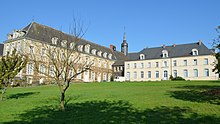Melleray Abbey
They chose a solitary location near Old Melleray, shown them by Rivallon, pastor of Auverné, which Alain de Moisdon, proprietor of the place, donated to them.This hollow tree marked the spot of the site of their new monastery, Meilleraie, which means honeycomb, and which in the long course of time has become Melleray.[2] A small monastery built for about twelve monks, Melleray remained regular in observance until during the sixteenth and seventeenth centuries, when relaxation prevailed.Etienne de Brezé (1544) was the first commendatory abbot, and from his time the monastery declined, until toward the end of the seventeenth century when, through the efforts of Jouard, vicar-general of the order, the Rule of St. Benedict was re-introduced, and the monastic buildings restored.[2] Although much of the soil of their property was stony and sterile they applied to it the skill learned from the improved methods of English farming, introducing new types of plows and the first threshing machine ever used in Brittany.
FrenchCistercianLa Meilleraye-de-BretagneChâteaubriantBrittanyLoire-AtlantiqueDiocese of NantesTrappistChemin Neuf CommunityLouroux AbbeyCîteauxcommendatory abbotRule of St. BenedictTrappistsValsainteAugustine de LestrangeThomas WeldCardinal WeldLulworthDorsetRevolution of 1830Mount Melleray AbbeyMount Saint Bernard AbbeyGethsemani AbbeyLa Grande TrappeNew Melleray Abbeypublic domainOuest-FranceCatholic Encyclopedia